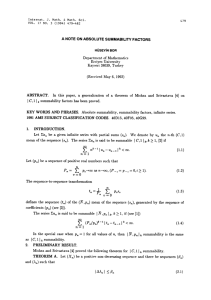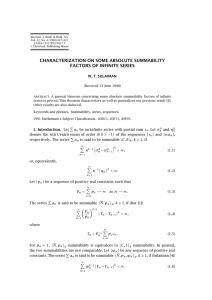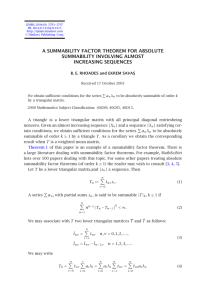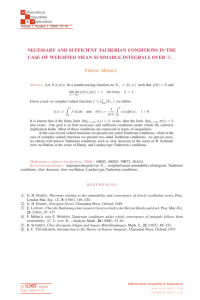Internat. J. Math. & Math. Sci. S0161171200002738 © Hindawi Publishing Corp.
advertisement
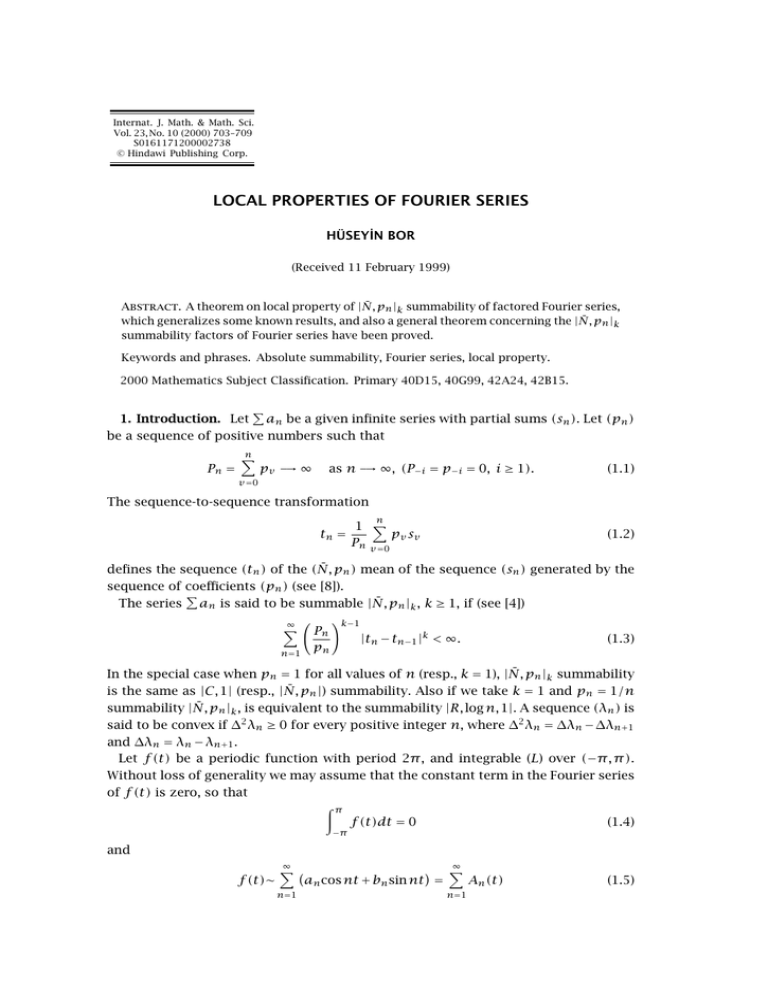
Internat. J. Math. & Math. Sci. Vol. 23, No. 10 (2000) 703–709 S0161171200002738 © Hindawi Publishing Corp. LOCAL PROPERTIES OF FOURIER SERIES HÜSEYİN BOR (Received 11 February 1999) Abstract. A theorem on local property of |N̄, pn |k summability of factored Fourier series, which generalizes some known results, and also a general theorem concerning the |N̄, pn |k summability factors of Fourier series have been proved. Keywords and phrases. Absolute summability, Fourier series, local property. 2000 Mathematics Subject Classification. Primary 40D15, 40G99, 42A24, 42B15. 1. Introduction. Let an be a given infinite series with partial sums (sn ). Let (pn ) be a sequence of positive numbers such that Pn = n pv → ∞ as n → ∞, (P−i = p−i = 0, i ≥ 1). (1.1) v=0 The sequence-to-sequence transformation tn = n 1 pv s v Pn v=0 (1.2) defines the sequence (tn ) of the (N̄, pn ) mean of the sequence (sn ) generated by the sequence of coefficients (pn ) (see [8]). The series an is said to be summable |N̄, pn |k , k ≥ 1, if (see [4]) k−1 ∞ Pn |tn − tn−1 |k < ∞. (1.3) pn n=1 In the special case when pn = 1 for all values of n (resp., k = 1), |N̄, pn |k summability is the same as |C, 1| (resp., |N̄, pn |) summability. Also if we take k = 1 and pn = 1/n summability |N̄, pn |k , is equivalent to the summability |R, log n, 1|. A sequence (λn ) is said to be convex if ∆2 λn ≥ 0 for every positive integer n, where ∆2 λn = ∆λn − ∆λn+1 and ∆λn = λn − λn+1 . Let f (t) be a periodic function with period 2π , and integrable (L) over (−π , π ). Without loss of generality we may assume that the constant term in the Fourier series of f (t) is zero, so that π f (t)dt = 0 (1.4) −π and f (t)∼ ∞ ∞ An (t) an cos nt + bn sin nt = n=1 n=1 (1.5) 704 HÜSEYİN BOR It is familiar that the convergence of the Fourier series at t = x is a local property of f (i.e., it depends only on the behaviour of f in an arbitrarily small neighbourhood of x), and hence the summability of the Fourier series at t = x by any regular linear summability method is also a local property of f . The local property problem of the factored Fourier series have been studied by several authors (see [1, 2, 5, 6, 7, 9]). Few of them are given below. 2. Mohanty [13] has demonstrated that the |R, log n, 1| summability of the factored Fourier series An (t) log(n + 1) (2.1) at t = x, is a local property of the generating function of f , whereas the |C, 1| summability of this series is not. Later on, Matsumoto [10] improved this result by replacing the series (2.1) by An (t) δ , log log(n + 1) δ > 1. (2.2) Generalizing the above result Bhatt [3] proved the following theorem. Theorem 2.1. If (λn ) is a convex sequence such that n−1 λn is convergent, then the summability |R, log n, 1| of the series An (t)λn log n at a point can be ensured by a local property. Mishra [12] has proved the following theorem by replacing the factor (λn log n) in the most general form. Theorem 2.2. Let the sequence (pn ) be such that Pn = O(npn ), Pn ∆pn = O(pn pn+1 ). (2.3) Then the summability |N̄, pn | of the series ∞ An (t)λn Pn , npn n=1 (2.4) at a point can be ensured by local property, where (λn ) is as in Theorem 2.1. But this theorem does not directly generalize any of the above mentioned results involving |R, log n, 1| summability since order relations are not satisfied by pn = 1/n. 3. The aim of this paper is to prove a more general theorem which includes some of the above mentioned results as special cases. Now, we shall prove the following theorem. Theorem 3.1. Let k ≥ 1. If (λn ) is a convex sequence such that pn λn is conver gent, then the summability |N̄, pn |k of the series An (t)λn Pn at a point can be ensured by a local property. We need the following lemmas for the proof of our theorem. LOCAL PROPERTIES OF FOURIER SERIES 705 Lemma 3.2 [11]. If (λn ) is a convex sequence such that pn λn is convergent, where (pn ) is a sequence of positive numbers such that Pn → ∞ as n → ∞, then (λn ) is a nonnegative monotonic decreasing sequence tending to zero, Pn λn = o(1) as n → ∞ and Pn ∆λn < ∞. Lemma 3.3. Let k ≥ 1. If (λn ) is a convex sequence such that pn λn is convergent and (sn ) is bounded, then the series an λn Pn is summable |N̄, pn |k . Proof. Let (Tn ) be the sequence of (N̄, pn ) mean of the series an λn Pn . Then, by definition, we have Tn = n n v 1 1 pv ar λr Pr = (Pn − Pv−1 )av λv Pv . Pn v=0 Pn v=0 r =0 (3.1) Then, for n ≥ 1, we have Tn − Tn−1 = n pn Pv−1 Pv av λv . Pn Pn−1 v=1 (3.2) By Abel’s transformation, we have Tn − Tn−1 = n−1 n−1 pn pn Pv Pv sv ∆λv − Pv s v pv λ v Pn Pn−1 v=1 Pn Pn−1 v=1 n−1 pn − Pv pv+1 sv λv+1 + sn pn λn Pn Pn−1 v=1 (3.3) = Tn,1 + Tn,2 + Tn,3 + Tn,4 . By Minkowski’s inequality for k > 1, to complete the proof of Lemma 3.3, it is sufficient to show that k−1 ∞ Pn |Tn,r |k < ∞, for r = 1, 2, 3, 4. (3.4) pn n=1 Now, applying Hölder’s inequality with indices k and k , where 1/k + 1/k = 1, we get that k−1 m+1 m+1 n−1 1 n−1 Pn k−1 pn k k |Tn,1 | ≤ |sv | Pv Pv ∆λv × Pv Pv ∆λv . pn P P Pn−1 v=1 n=2 n=2 n n−1 v=1 (3.5) Since n−1 Pv Pv ∆λv ≤ Pn−1 v=1 n−1 Pv ∆λv , (3.6) v=1 it follows by Lemma 3.2 that 1 n−1 Pn−1 v=1 Pv Pv ∆λv ≤ n−1 v=1 Pv ∆λv = O(1) as m → ∞. (3.7) 706 HÜSEYİN BOR Therefore m+1 n=2 Pn pn k−1 |Tn,1 |k = O(1) m+1 n=2 m = O(1) n−1 pn |sv |k Pv Pv ∆λv Pn Pn−1 v=1 |sv |k Pv Pv ∆λv v=1 m = O(1) m+1 pn P P n=v+1 n n−1 Pv ∆λv = O(1) (3.8) as m → ∞, v=1 by virtue of the hypotheses and Lemma 3.2. Again m+1 n=2 Pn pn k−1 |Tn,2 |k ≤ m+1 n=2 k−1 n−1 1 n−1 pn |sv |k (Pv λv )k pv × pv . Pn−1 Pn Pn−1 v=1 v=1 = O(1) m+1 v=2 = O(1) m n−1 pn |sv |k (Pv λv )k pv Pn Pn−1 v=1 m+1 pn P Pn−1 n n=v+1 |sv |k (Pv λv )k pv v=1 = O(1) m |sv |k (Pv λv )k v=1 = O(1) m (3.9) pv Pv |sv |k (Pv λv )k−1 pv λv v=1 = O(1) m pv λv = O(1) as m → ∞, v=1 by virtue of the hypotheses and Lemma 3.2. Using the fact that Pv < Pv+1 , similarly we have that m+1 n=2 Pn pn k−1 |Tn,3 |k = O(1) m pv+1 λv+1 = O(1) as m → ∞, (3.10) v=1 Finally, we have that m n=1 Pn pn k−1 |Tn,4 |k = m |sn |k (Pn λn )k−1 pn λn n=1 = O(1) m (3.11) pn λn = O(1) as m → ∞, n=1 by virtue of the hypotheses and Lemma 3.2. Therefore, we get that m n=1 Pn pn k−1 |Tn,r |k = O(1) This completes the proof of Lemma 3.3. as m → ∞, for r = 1, 2, 3, 4. (3.12) LOCAL PROPERTIES OF FOURIER SERIES 707 In the particular case if we take pn = 1 for all values of n in this lemma, then we get the following corollary. Corollary 3.4. Let k ≥ 1. If (λn ) is a convex sequence such that λn is convergent and (sn ) is bounded, then the series nan λn is summable |C, 1|k . Proof of Theorem 3.1. Since the behaviour of the Fourier series, as far as convergence is concerned, for a particular value of x depends on the behaviour of the function in the immediate neighbourhood of this point only, hence the truth of the theorem is a necessary consequence of Lemma 3.3. If we take pn = 1 for all values of n in this theorem, then we get a local property result concerning the |C, 1|k summability. Now we shall prove the following theorem for |N̄, pn |k summability factors of Fourier series. Theorem 3.5. Let k ≥ 1 and let (λn ) be a convex sequence such that pn λn < ∞, n where (pn ) is a sequence of positive numbers such that Pn → ∞. If v=1 Pv Av (t) = O(Pn ), then the series An (t)Pn λn is summable |N̄, pn |k , where Av (t) is as in (1.5). Proof. Let Tn (t) denotes the (N̄, pn ) mean of the series An (t)Pn λn . Then, by definition, we have Tn = n n v 1 1 pv Ar (t)Pr λr = (Pn − Pv−1 )Av (t)λv Pv . Pn v=0 Pn v=0 r =0 (3.13) Then, for n ≥ 1, we have Tn (t) − Tn−1 (t) = n pn Pv−1 Pv Av (t)λv . Pn Pn−1 v=1 (3.14) By Abel’s transformation, we have n−1 n v pn pn ∆(Pv−1 λv ) Pr Ar (t) + λn Pv Av (t) Pn Pn−1 v=1 Pn r =1 v=1 n−1 p n (Pv λv − pv λv − Pv λv+1 )Pv + O(1)pn λn = O(1) Pn Pn−1 v=1 n−1 n−1 p pn n = O(1) Pv Pv λv − Pv pv λv + pn λn Pn Pn−1 Pn Pn−1 v=1 v=1 = O(1) Tn,1 (t) + Tn,2 (t) + Tn,3 (t) . Tn (t) − Tn−1 (t) = (3.15) Since |Tn,1 (t) + Tn,2 (t) + Tn,3 (t)|k ≤ 3k |Tn,1 (t)|k + |Tn,2 (t)|k + |Tn,3 (t)|k , (3.16) to complete the proof of Theorem 3.5, it is sufficient to show that ∞ n=1 Pn pn k−1 |Tn,r (t)|k < ∞, for r = 1, 2, 3. (3.17) 708 HÜSEYİN BOR Now, applying Hölder’s inequality with indices k and k , where 1/k + 1/k = 1 and by using (3.7), we get that k−1 m+1 m+1 n−1 1 n−1 Pn k−1 pn k |Tn,1 (t)| ≤ Pv Pv ∆λv × Pv Pv ∆λv . pn P P Pn−1 v=1 n=2 n=2 n n−1 v=1 = O(1) m+1 n=2 = O(1) m n−1 pn Pv Pv ∆λv Pn Pn−1 v=1 Pv Pv ∆λv v=1 = O(1) m m+1 pn P Pn−1 n n=v+1 Pv ∆λv = O(1) as m → ∞, v=1 m+1 n=2 Pn pn k−1 k |Tn,2 (t)| ≤ m+1 n=2 (3.18) k−1 n−1 1 n−1 pn k (Pv λv ) pv × pv . Pn Pn−1 v=1 Pn−1 v=1 = O(1) m+1 v=2 = O(1) m n−1 pn (Pv λv )k pv Pn Pn−1 v=1 (Pv λv )k pv v=1 m+1 pn P P n=v+1 n n−1 (3.19) m pv = O(1) (Pv λv )k Pv v=1 = O(1) m (Pv λv )k−1 pv λv v=1 = O(1) m pv λv = O(1) as m → ∞, v=1 by virtue of the hypotheses and Lemma 3.2. Finally, as in Tn,1 (t), we have that k−1 m m Pn |Tn,3 (t)|k = (Pn λn )k−1 pn λn pn n=1 n=1 = O(1) m pn λn = O(1) (3.20) as m → ∞, n=1 Therefore, we get that k−1 m Pn |Tn,r (t)|k = O(1) p n n=1 as m → ∞, for r = 1, 2, 3. (3.21) This completes the proof of Theorem 3.5. As a special case the following results can be obtained from Theorem 3.5. (1) If we take pn = 1 for all values of n, then we get a result concerning the |C, 1|k summability factors of Fourier series. LOCAL PROPERTIES OF FOURIER SERIES 709 (2) If we take k = 1 and pn = 1/n, then we get another new result related to |R, log n, 1| summability factors of Fourier series. References [1] [2] [3] [4] [5] [6] [7] [8] [9] [10] [11] [12] [13] S. Baron, Local property of absolute summability of Fourier series, Tartu Riikl. Ül. Toimetised Vih. 177 (1965), 106–120. MR 35#2073. Zbl 166.07201. S. N. Bhatt, An aspect of local property of |R, log n, 1| summability of Fourier series, Tohoku Math. J. (2) 11 (1959), 13–19. MR 21#6504. Zbl 107.05303. , An aspect of local property of |R, log n, 1| summability of the factored Fourier series, Proc. Nat. Inst. Sci. India Part A 26 (1960), 69–73. MR 28#1444. Zbl 098.04401. H. Bor, On two summability methods, Math. Proc. Cambridge Philos. Soc. 97 (1985), no. 1, 147–149. MR 86d:40004. Zbl 554.40008. , Local property of |N̄, pn |k summability of factored Fourier series, Bull. Inst. Math. Acad. Sinica 17 (1989), no. 2, 165–170. MR 91e:42007. Zbl 697.42006. , On the local property of |N̄, p n |k summability of factored Fourier series, J. Math. Anal. Appl. 163 (1992), no. 1, 220–226. MR 93b:42013. Zbl 764.42002. D. Borwein, The nonlocal nature of the summability of Fourier series by certain absolute Riesz methods, Proc. Amer. Math. Soc. 114 (1992), no. 1, 89–94. MR 92c:42006. Zbl 753.42006. G. H. Hardy, Divergent Series, Oxford, at the Clarendon Press, 1949. MR 11,25a. Zbl 032.05801. M. Izumi and S. Izumi, Localization problem of the absolute Riesz and absolute Nörlund summabilities of Fourier series, Canad. J. Math. 22 (1970), 615–625. MR 41#8915. Zbl 205.08501. K. Matsumoto, Local property of the summability |R, λn , 1|, Tohoku Math. J. (2) 8 (1956), 114–124. MR 18,208b. Zbl 071.28403. S. M. Mazhar, On the summability factors of infinite series, Publ. Math. Debrecen 13 (1966), 229–236. MR 35#3313. Zbl 166.31602. K. N. Mishra, Multipliers for |N̄, pn | summability of Fourier series, Bull. Inst. Math. Acad. Sinica 14 (1986), no. 4, 431–438. MR 88e:42013. Zbl 635.42011. R. Mohanty, On the summability |R, logw, 1| of a Fourier series, J. London Math. Soc. 25 (1950), 67–72. MR 11,592b. Zbl 035.33602. Bor: Department of Mathematics, Erciyes University, 38039 Kayseri, Turkey E-mail address: bor@erciyes.edu.tr

